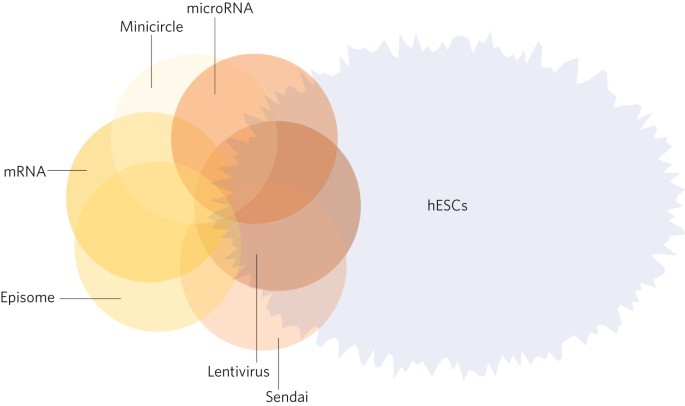
The reprogramming method matters
- Select a language for the TTS:
- UK English Female
- UK English Male
- US English Female
- US English Male
- Australian Female
- Australian Male
- Language selected: (auto detect) - EN
Play all audios:
The genetic, epigenetic and transcriptomic profiles of human induced pluripotent stem cells are shaped by the reprogramming route. Access through your institution Buy or subscribe This is a
preview of subscription content, access via your institution ACCESS OPTIONS Access through your institution Access Nature and 54 other Nature Portfolio journals Get Nature+, our best-value
online-access subscription $32.99 / 30 days cancel any time Learn more Subscribe to this journal Receive 12 digital issues and online access to articles $119.00 per year only $9.92 per issue
Learn more Buy this article * Purchase on SpringerLink * Instant access to full article PDF Buy now Prices may be subject to local taxes which are calculated during checkout ADDITIONAL
ACCESS OPTIONS: * Log in * Learn about institutional subscriptions * Read our FAQs * Contact customer support CHANGE HISTORY * _ 02 JANUARY 2018 In the version of this News and Views article
originally published, an erroneous hyphen was included in the term ‘human-induced pluripotent stem cells’; it should have read ‘human induced pluripotent stem cells’. This error has now
been corrected in all versions of the News and Views article. _ REFERENCES * Takahashi, K. et al. _Cell_ 131, 861–872 (2007). Article CAS PubMed Google Scholar * Bock, C. et al. _Cell_
144, 439–452 (2011). Article CAS PubMed PubMed Central Google Scholar * Chin, M., Mason, M., Xie, W., Volinia, S. & Singer, M. _Cell Stem Cell_ 5, 111–123 (2009). Article CAS
PubMed PubMed Central Google Scholar * Ruiz, S. et al. _Proc. Natl Acad. Sci. USA_ 109, 16196–16201 (2012). Article CAS PubMed PubMed Central Google Scholar * Churko, J. M. et al.
_Nat. Biomed. Eng._ https://doi.org/10.1038/s41551-017-0141-6 (2017). Article Google Scholar * Amps, K. et al. _Nat. Biotech_ 29, 1132–1144 (2011). Article CAS Google Scholar * Baker,
D. et al. _Stem Cell Rep_ 7, 998–1012 (2016). Article CAS Google Scholar * Huangfu, D. et al. _Nat. Biotechnol._ 26, 795–797 (2008). Article CAS PubMed Google Scholar Download
references AUTHOR INFORMATION AUTHORS AND AFFILIATIONS * Department of Biological Chemistry, David Geffen School of Medicine, University of California, Los Angeles, Los Angeles, CA, 90095,
USA Thomas F. Allison * Department of Molecular, Cell, and Developmental Biology, University of California, Los Angeles, Los Angeles, CA, 90095, USA Thomas F. Allison & William E. Lowry
* Molecular Biology Institute, University of California, Los Angeles, Los Angeles, CA, 90095, USA William E. Lowry * Eli and Edythe Broad Center of Regenerative Medicine and Stem Cell
Research, University of California, Los Angeles, Los Angeles, CA, 90095, USA Thomas F. Allison & William E. Lowry * Department of Dermatology, David Geffen School of Medicine, University
of California, Los Angeles, Los Angeles, CA, 90095, USA William E. Lowry * Jonsson Comprehensive Cancer Center, David Geffen School of Medicine, University of California, Los Angeles, Los
Angeles, CA, 90095, USA William E. Lowry Authors * Thomas F. Allison View author publications You can also search for this author inPubMed Google Scholar * William E. Lowry View author
publications You can also search for this author inPubMed Google Scholar CORRESPONDING AUTHOR Correspondence to William E. Lowry. ADDITIONAL INFORMATION A correction to this article is
available online at https://doi.org/10.1038/s41551-017-0170-1. RIGHTS AND PERMISSIONS Reprints and permissions ABOUT THIS ARTICLE CITE THIS ARTICLE Allison, T.F., Lowry, W.E. The
reprogramming method matters. _Nat Biomed Eng_ 1, 779–781 (2017). https://doi.org/10.1038/s41551-017-0148-z Download citation * Published: 10 October 2017 * Issue Date: October 2017 * DOI:
https://doi.org/10.1038/s41551-017-0148-z SHARE THIS ARTICLE Anyone you share the following link with will be able to read this content: Get shareable link Sorry, a shareable link is not
currently available for this article. Copy to clipboard Provided by the Springer Nature SharedIt content-sharing initiative